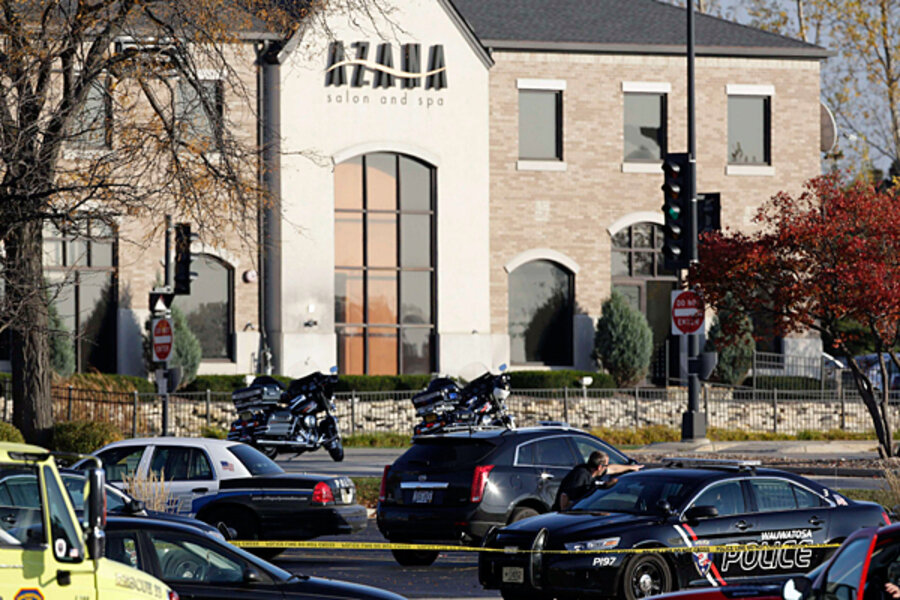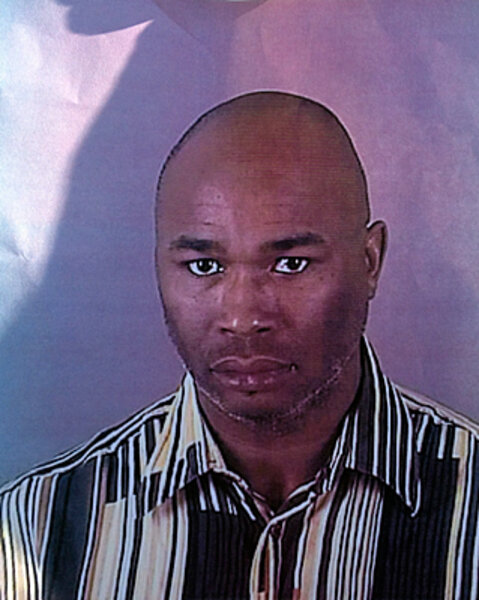Wisconsin spa killings: Shooting followed tragic script of domestic violence
Loading...
| Chicago
The circumstances involved in a mass killing outside Milwaukee on Sunday correspond to what many already know about domestic partner abuse: The signs are often as clear as day that the situation will one day turn deadly.
Radcliffe Haughton shot seven women, killing three, and then himself at a spa in Brookfield, Wis., a suburb west of Milwaukee, Sunday. One of the victims is Zina Haughton, his estranged wife. In her recent application for a restraining order, Ms. Haughton said her husband “said he would kill me if I left him or ever contacted the police.”
The shooting took place three weeks into what the National Coalition Against Domestic Violence recognizes as Domestic Violence Awareness Month. According to a survey on criminal victimization conducted by the Bureau of Justice Statistics and released last week, the number of incidents of domestic violence jumped 20 percent in 2011, from 1.1 million to 1.4 million, over the previous year. Between 2002 and 2011, these same incidents increased 3 percent. The data does not track homicides.
The large majority of these assaults are classified as intimate partner violence, a subset designation addressing violence between current or former spouses, boyfriends, or girlfriends. In 2011 alone, intimate partner violence accounted for 63 percent of domestic violence incidents. Even though violence between partners increased 10 percent from 2010 to 2011, it was still down 8 percent from 2002.
Intimate partner violence typically involves serial batterers who commit the same acts over a sustained period of time, a trajectory that runs counter to what researchers know about general violent offenders, whose deadly behavior tends to diminish with age.
“If anything, [batterers] tend to get more violent over time,” says Angela Hattery, an associate director of women and gender studies at George Mason University in Washington who has written extensively on intimate partner violence.
Details emerging about Radcliffe and Zina Haughton suggest their relationship was at a high risk for homicide dating back nearly two years.
On Jan. 8, 2011, police were called to their home in the village of Brown Deer, a Milwaukee suburb, where police saw Radcliffe Haughton at the front window with what looked to be a shotgun. Zina Haughton told police her husband threw her clothes and bedding outside and poured tomato juice on her vehicle. She said her husband did not own any guns. The standoff took 90 minutes but did not end in Mr. Haughton’s arrest. Instead, according to the Milwaukee Journal-Sentinel, police took the unusual step of asking county prosecutors to later charge Mr. Haughton with misdemeanor disorderly conduct, domestic abuse.
The charge was dismissed a week later after both Zina Haughton and a police officer tasked with identifying her husband failed to show up in court.
Police returned to the home Oct. 2 this year, once again in response to a call from Zina Haughton. Upon their arrival, they reported bruises on her face although she denied being assaulted by her husband, who was not home at the time of their arrival. She was granted a four-year restraining order against Radcliffe Haughton on Oct. 8, and last Thursday a court issued an injunction barring him from possessing firearms.
Ms. Hattery says the narrative is “very typical” of intimate partner abuse that ends in homicide.
“Victims are often afraid to tell the truth about what is happening. They are afraid [the batterer] has a gun, so they are trying to de-escalate the situation,” she says. “One thing we know is [the homicide] often occurs when victims try to leave a relationship.”
Also troublesome are data that show, in most cases, there is little accountability for those facing charges related to domestic violence. Oftentimes the charges are dropped – as was the case with Haughton – or defendants are assigned to an intervention program that addresses ancillary issues like anger management or substance abuse.
Hattery’s research shows that, in most counties across the US, more than half of those with domestic violence convictions complete just half the sessions, while nearly half don’t bother to show up at all.
The severity of punishment depends on the awareness of the court system addressing each case, says Hattery.
“It is very locally dependent: In communities where you have a lot of activism from organizations fighting domestic violence, you have a lot of support inside the local justice system. In counties where there’s not a lot of traction, there’s not nearly enough of a response,” she says. “A lot of people walk around with a sanitized version of [domestic violence], I don’t think they truly understand the depths of it. If they did, it would be hard for most decent people to turn away.”
Another factor working against Zina Haughton was her gender. Most victims of intimate partner violence are women, according to a 2010 study by the National Center for Injury Prevention and Control in Atlanta that found about 1 in 4 women (24.3 percent) and 1 in 7 men (13.8 percent) have experienced severe physical violence by an intimate partner.
The 2010 annual crime report published by the Federal Bureau of Investigation found that 4.6 percent of homicide victims that year were wives, compared with 1 percent of husbands. The same dynamic is true of girlfriends to boyfriends: 3.8 percent to 1 percent. Data for 2011 has not yet been released.
Years ago the gap was tighter, but what helped lower victim rates for men was the emergence of domestic abuse outreach organizations that women seek out for safety, says Katherine van Wormer, who teaches social work at the University of Northern Iowa in Cedar Falls and who has written on domestic abuse.
“The homicide rate numbers were about equal before the days of women’s shelters and hotlines. The women often acted in self-defense because they were scared to death. Now there’s an alternative [to homicide] for women,” Ms. van Wormer says.
Zina Haughton wrote that her husband thought she was unfaithful and described the threats as both physical and verbal in her application for the restraining order, filed in the circuit court for Milwaukee County and dated Oct. 8.
“His threats terrorize my every waking moment,” she wrote, saying he threatened to throw acid at her or burn her and her family with gas. “He said he would kill me if I left him or ever contacted the police.”







